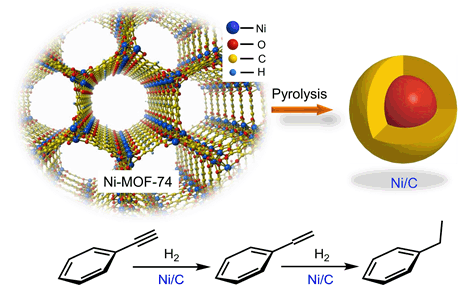| [1] (a) Wu, Z. L.; Cravotto, G.; Gaudino, E. C.; Giacomino, A.; Medlock, J.; Bonrath, W. Ultrason. Sonochem. 2017, 35, 664.
(b) Yang, K. X.; Chen, X.; Guan, J. C.; Liang, C. H. Catal. Today 2015, 246, 176.
[2] Wang, B.; Sun, L. M.; Ma, H. W.; Zheng, Y. D.; Hu, X. L.; Yang, H. Q.; Liang, S. Q. Contemp. Chem. Ind. 2015, 2048. (王斌, 孙利民, 马好文, 郑云弟, 胡晓丽, 杨红强, 梁顺琴, 当代化工, 2015, 2048.)
[3] Berenblyum, A. S.; Al-Wadhaf, H. A.; Katsman, E. A. Petrol. Chem. 2015, 55, 118.
[4]
(a) Mastalir, Á.; Király, Z. J. Catal. 2003, 220, 372;
(b) Erokhin, A. V.; Lokteva, E. S.; Yermakov, A. Y.; Boukhvalov, D. W.; Maslakov, K. I.; Golubina, E. V.; Uimin, M. A. Carbon 2014, 74, 291.
[5] Su, D. S.; Perathoner, S.; Centi, G. Chem. Rev. 2013, 113, 5782.
[6] Li, S. Q.; Liu, J. T.; Sun, F. X.; Wang, W. M.; Cheng, Y. L. CN101475438, 2009[Chem. Abstr. 2009, 35, 840049].
[7] Beyhaghi, M.; Kiani-Rashid, A. R.; Kashefi, M.; Khaki, J. V.; Jonsson, S. Appl. Surf. Sci. 2015, 344, 1.
[8]
(a) Cho, G. S.; Lim, J. K.; Choe, K. H.; Lee, W. Mater. Sci. Forum 2010, 658, 360;
(b) Wu, C. Z.; Yao, X. D.; Zhang, H. Int. J. Hydrogen Energy 2010, 35, 247.
[9] Manukyan, A.; Mirzakhanyan, A.; Sajti, L.; Khachaturyan, R.; Kaniukov, E.; Lobanovsky, L.; Sharoyan, E. Nano 2015, 10, 7.
[10] Meng, Z. Q.; Li, X. B.; Xiong, Y. J.; Zhan, J. T. Nonferr. Metal. Soc. 2012, 22, 2719.
[11] Li, X.; Cheng, H.; Fan, J. Powder Metall. Technol. 2009, 27, 142.
[12] Shen, K.; Chen, X.; Chen, J.; Li, Y. ACS Catal. 2016, 6, 5887.
[13] Meek, S. T.; Greathouse, J. A.; Allendorf, M. D. Adv. Mater. 2011, 23, 249.
[14] Dietzel, P. D.; Panella, B.; Hirscher, M.; Blom, R.; Fjellvag, H. Chem. Commun. 2006, 959.
[15] Dietzel, P. D.; Morita, Y.; Blom, R.; Fjellvag, H. Angew. Chem., Int. Ed. 2005, 44, 6354.
[16] Grant Glover, T.; Peterson, G. W.; Schindler, B. J.; Britt, D.; Yaghi, O. Chem. Eng. Sci. 2011, 66, 163.
[17] An, C.; Liu, G.; Li, L.; Wang, Y.; Chen, C.; Wang, Y.; Jiao, L.; Yuan, H. Nanoscale 2014, 6, 3223.
[18] Zhou, L.; Zhang, T.; Tao, Z.; Chen, J. Nano Res. 2014, 7, 774.
[19]
(a) Paul, R.; Sharma, M. K.; Chatterjee, R.; Hussain, S.; Bhar, R.; Pal, A. K. Appl. Surf. Sci. 2012, 258, 5850;
(b) Wang, H.; Cao, Y.; Zou, G.; Yi, Q.; Guo, J.; Gao, L. ACS Appl. Mater. Interfaces 2017, 9, 60;
(c) Kovacs, G. J.; Bertoti, I.; Radnoczi, G. Thin Solid Films 2008, 516, 7942.
[20]
(a) Leng, Y. G.; Shao, H. Y.; Wang, Y. T.; Suzuki, M.; Li, X. G. J. Nanosci. Nanotechnol. 2006, 6, 221;
(b) Hasegawa, M.; Sugawara, K.; Suto, R.; Sambonsuge, S.; Teraoka, Y.; Yoshigoe, A.; Filimonov, S.; Fukidome, H.; Suemitsu, M. Nanoscale Res. Lett. 2015, 10, 421.
[21] Golubina, E. V.; Lokteva, E. S.; Erokhin, A. V.; Veligzhanin, A. A.; Zubavichus, Y. V.; Likholobov, V. A.; Lunin, V. V. J. Catal. 2016, 344, 90.
[22] Guo, J. X.; Liang, J.; Chu, Y. H.; Sun, M. C.; Yin, H. Q.; Li, J. J. Appl. Catal. A: Gen. 2012, 421, 142.
[23] Park, S. J.; Jung, W. Y. J. Colloid Interface Sci. 2002, 250, 93.
[24] Wang, Z. M.; Yamashita, N.; Wang, Z. X.; Hoshinoo, K.; Kanoh, H. J. Colloid Interface Sci. 2004, 276, 143.
[25] Ortega, K. F.; Arrigo, R.; Frank, B.; Schlogl, R.; Trunschke, A. Chem. Mater. 2016, 28, 6826.
[26] Oswald, S.; Bruckner, W. Surf. Interface Anal. 2004, 36, 17.
[27] Carraro, P. M.; Blanco, A. A. G.; Soria, F. A.; Lener, G.; Sapag, K.; Eimer, G. A.; Oliva, M. I. Microporous Mesoporous Mater. 2016, 231, 31.
[28] Cheng, C. B.; Shen, D. K.; Xiao, R.; Wu, C. F. Fuel 2017, 189, 419.
[29] Rodriguez-Gomez, A.; Caballero, A. ChemNanoMat 2017, 3, 94.
[30] Liu, L. J.; Lou, H.; Chen, M. Int. J. Hydrogen Energy 2016, 41, 14721.
[31] Hu, D.; Gao, J.; Ping, Y.; Jia, L.; Gunawan, P.; Zhong, Z.; Xu, G.; Gu, F.; Su, F. Ind. Eng. Chem. Res. 2012, 51, 4875.
[32] Yang, K. X.; Chen, X.; Wang, L.; Zhang, L. L.; Jin, S. H.; Liang, C. H. ChemCatChem 2017, 9, 1337.
[33]
(a) Carturan, G.; Facchin, G.; Gottardi, V.; Guglielmi, M.; Navazio, G. J. Non-Cryst. Solids 1982, 48, 219;
(b) Costa, M.; Pelagatti, P.; Pelizzi, C.; Rogolino, D. J. Mol. Catal. A: Chem. 2002, 178, 21.
[34] Chen, X.; Li, M.; Guan, J.; Wang, X.; Williams, C. T.; Liang, C. Ind. Eng. Chem. Res 2012, 51, 3604.
[35] Kulikov, L. A.; Terenina, M. V.; Kryazheva, I. Y.; Karakhanov, E. A. Petro. Chem. 2017, 57, 222.
[36] Zhang, W.; Wang, F. S.; Li, X. L.; Liu, Y. S.; Liu, Y.; Ma, J. T. Appl. Surf. Sci. 2017, 404, 398.
[37] Boronoev, M. P.; Subbotina, E. S.; Kurmaeva, A. A.; Kardasheva, Y. S.; Maksimov, A. L.; Karakhanov, E. A. Petrol. Chem. 2016, 56, 109.
[38]
(a) Chen, W.; Pan, X. L.; Bao, X. H. J. Am. Chem. Soc. 2007, 129, 7421;
(b) Chen, W.; Pan, X. L.; Willinger, M. G.; Su, D. S.; Bao, X. H. J. Am. Chem. Soc. 2006, 128, 3136.
[39] Fu, Q.; Bao, X. H. Chin. J. Catal. 2015, 36, 517.
[40] Deng, J.; Ren, P. J.; Deng, D. H.; Bao, X. H. Angew. Chem. Int. Ed. 2015, 54, 2100.
[41] Chen, X.; Li, M.; Guan, J.; Wang, X.; Williams, C. T.; Liang, C. Ind. Eng. Chem. Res. 2012, 51, 3604. |
